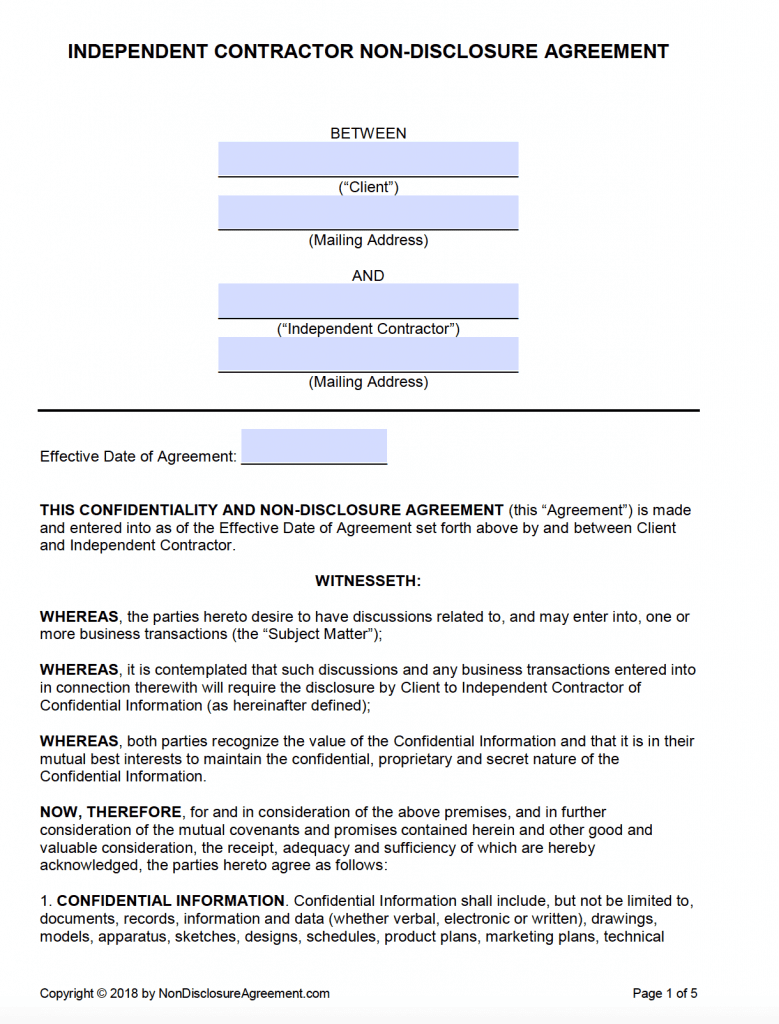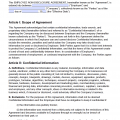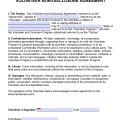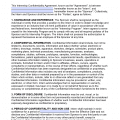Independent Contractor Non-Disclosure Agreement (NDA)

The independent contractor non-disclosure agreement is intended for use with workers (sometimes known as “1099 contractors” because of their tax status) who perform tasks for you or your business. Unlike employees, independent contractors are not bound to maintain secrecy under most state laws. That is, if you disclose a trade secret to a contractor without a nondisclosure agreement in place, the contractor is not bound to maintain secrecy. For that reason, the best strategy to protect your secret information is to sign a written nondisclosure agreement with the contractor. If the agreement is breached—if the information is disclosed without your authorization—you can sue for monetary damages. Because contractors can perform a wide range of activities—from accountants to window washers—the agreement does not detail specifically what is secret, and instead relies on the trade secret owner to label materials as confidential, whether written or oral. Note, this not an agreement that details the terms of hiring (payment, deliverables, etc.). Also, if you use a non-disclosure agreement with one contractor, you should use it for all contractors exposed to the same information. Otherwise, someone who signed a non-disclosure might argue that you didn’t consistently treat the information as being confidential.
Employee NDA – For businesses that want to protect their proprietary information from being released during or after an individual’s employment.
Sample
INDEPENDENT CONTRACTOR NON-DISCLOSURE AGREEMENT
This independent contractor non-disclosure agreement (the “Agreement”) is made between _________________ (the “Hiring Party”) and _________________ (the “Contractor”) and is effective _________________. The parties agree as follows:
Hiring Party has engaged Contractor to perform the following services: _________________________________________________________ (the “Contractor Services”). During the performance of Contractor Services, Contractor may be exposed to Confidential Information (as defined below). The Agreement is intended to prevent the unauthorized disclosure of Confidential Information.
“Confidential Information” is proprietary information relating to Hiring Party’s business including but not limited to: business and financial records, intellectual property, proprietary data, security measures, or any other financial information that, if disclosed, could affect the business of Hiring Party. Confidential information, if written, will be labeled as confidential.
Without Hiring Party’s prior written consent, Contractor will not: (a) disclose Confidential Information to any third party; (b) make or permit to be made copies or other reproductions of Confidential Information; or (c) make any commercial use of Confidential Information. The contractor will carefully restrict access to Confidential Information to those of its officers, directors, and employees who are subject to non-disclosure restrictions at least as protective as those set forth in this Agreement and who clearly need such access to participate on Contractor’s behalf to perform Contractor Services.
4. Return of Confidential Materials
Upon Hiring Party’s request, Contractor shall immediately return all original materials provided by Hiring Party and any copies, notes or other documents in Contractor’s possession pertaining to Confidential Information.
This agreement does not apply to any information that: (a) was in Contractor’s possession or was known to Contractor, without an obligation to keep it confidential, before such information was disclosed to Contractor by Hiring Party; (b) is or becomes public knowledge through a source other than Contractor and through no fault of Contractor; (c) is or becomes lawfully available to Contractor from a source other than Hiring Party; or (d) is disclosed by Contractor with Hiring Party’s prior written approval.
This Agreement and Contractor’s duty to hold Confidential Information in confidence shall remain in effect until _________________ or until whichever of the following occurs first: (a) Hiring Party sends Contractor written notice releasing it from this Agreement, or (b) Confidential Information disclosed under this Agreement ceases to be confidential.
7. Notice of Immunity from Liability.
An individual shall not be held criminally or civilly liable under any federal or state trade secret law for the disclosure of a trade secret that is made (i) in confidence to a federal, state, or local government official, either directly or indirectly, or to an attorney; and (ii) solely for the purpose of reporting or investigating a suspected violation of law; or is made in a complaint or other document filed in a lawsuit or other proceeding, if such filing is made under seal. An individual who files a lawsuit for retaliation by an employer for reporting a suspected violation of law may disclose the trade secret to the attorney of the individual and use the trade secret information in the court proceeding, if the individual (i) files any document containing the trade secret under seal; and (ii) does not disclose the trade secret, except pursuant to court order.
(a) Relationships. Nothing contained in this Agreement shall be deemed to constitute either party a partner, joint venturer or employee of the other party for any purpose.
(b) Severability. If a court finds any provision of this Agreement invalid or unenforceable, the remainder of this Agreement shall be interpreted so as best to effect the intent of the parties.
(c) Integration. This Agreement expresses the complete understanding of the parties with respect to the subject matter and supersedes all prior proposals, agreements, representations, and understandings. This Agreement may not be amended except in a writing signed by both parties.
(d) Waiver. The failure to exercise any right provided in this Agreement shall not be a waiver of prior or subsequent rights.
(e) Injunctive Relief. Any misappropriation of Confidential Information in violation of this Agreement may cause Hiring Party irreparable harm, the amount of which may be difficult to ascertain, and therefore Contractor agrees that Hiring Party shall have the right to apply to a court of competent jurisdiction for an order enjoining any such further misappropriation and for such other relief as Hiring Party deems appropriate. This right of Hiring Party is to be in addition to the remedies otherwise available to Hiring Party.
(f) Governing Law. This Agreement shall be governed in accordance with the laws of the State of _________________.
(g) Jurisdiction. The parties consent to the exclusive jurisdiction and venue of the federal and state courts located in _________________ in any action arising out of or relating to this Agreement. The parties waive any other venue to which either party might be entitled by domicile or otherwise.
(h) Successors & Assigns. This Agreement shall bind each party’s heirs, successors and assigns. The contractor may not assign or transfer its rights or obligations under this Agreement without the prior written consent of Hiring Party. However, no consent is required for an assignment or transfer that occurs: (a) to an entity in which Contractor owns more than fifty percent of the assets; or (b) as part of a transfer of all or substantially all of the assets of Contractor to any party. Any assignment or transfer in violation of this section shall be void.
Hiring Party:
_____________________________________________ (Signature)
_____________________ (Typed or Printed Name)
Title: _____________________
Date: _____________________
Contractor:
_____________________________________________ (Signature)
_____________________ (Typed or Printed Name)
Title: _____________________
Date: _____________________
How to Write
EXPLANATION FOR INDEPENDENT CONTRACTOR NON-DISCLOSURE AGREEMENT
Below we provide an explanation for each of the provisions in the Independent Contractor Non-Disclosure Agreement.
Introductory Paragraph
Fill in the name or company name of the Hiring Party. That’s the party revealing financial information (that’s likely to be you, the person preparing this agreement). Fill in the name of the individual or company that will receive or have access to the financial information (the Contractor). Finally, fill in the date the agreement will take effect. This is often the date that the last party signs the agreement.
1. The Contractor Services
This clause identifies that the services that the Contractor is performing. Provide a simple summary of the work.
2. Confidential Information
This section defines what is protected against disclosure. Keep in mind that if you are providing documentation, you should designate that information as confidential. If the information is spoken, you should announce the confidentiality.
3. Non-Disclosure
This clause makes clear that your trade secrets must be kept in confidence by the Contractor and may not be revealed to others without your prior written consent.
4. Return of Materials
The Contractor promises to return materials that you provided. The agreement gives the Contractor 30 days to return the materials, but you can change this time period if you wish.
5. Exclusions
This provision describes all the types of information that are not covered by the agreement. These exclusions are based on court decisions and state trade secret laws that say these types of information do not qualify for trade secret protection.
6. Term
This clause provides the Contractor with an expiration date for the agreement. The Agreement should last as long as the information is likely to remain a trade secret. Five years is a common period, but it can be much shorter, even as little as six months.
7. Notice of Immunity from Liability
Including this provision enables the hiring party to qualify for double damages and attorney fees under the federal Defend Trade Secrets Act.
8. General Provisions
These miscellaneous provisions (sometimes referred to as “boilerplate”) are usually grouped together at the end of an agreement.
(a) Relationships. Most agreements include a provision like this one, disclaiming any relationship other than that defined in the agreement.
(b) Severability. The severability clause provides that if you wind up in a lawsuit over the agreement and a court rules that one part of the agreement is invalid, that part can be cut out and the rest of the agreement will remain valid.
(c) Integration. The integration provision verifies that the version you are signing is the final version and that neither of you can rely on statements made in the past.
(d) Waiver. This provision states that even if you don’t promptly complain about a violation of the NDA, you still have the right to complain about it later.
(e) Injunctive Relief. An injunction is a court order directing a person to do (or stop doing) something. If someone violated your NDA, you would want a court order directing that person to stop using your secrets.
(f) Governing Law. You can choose any state’s laws to govern the agreement, though the most logical state for this provision is the state where you (Hiring Party) are located.
(g) Jurisdiction. The purpose of adding a jurisdiction provision to an NDA is to get each party to consent in advance to jurisdiction in one county or state and to give up the right to sue or be sued anywhere else. As with the previous provision, the most likely choice is the county and state in which you (Hiring Party) are located.
(h) Successors and Assigns. This provision binds any company that acquires either party.
Signing the agreement. Someone with the necessary authority must sign the agreement on behalf of each party. Each party should sign two copies and keep one. This way, both parties have an original signed agreement.




